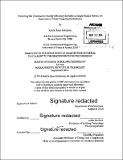| dc.contributor.advisor | Leslie Norford. | en_US |
| dc.contributor.author | Goldstein, Kaitlin Ryan | en_US |
| dc.contributor.other | Massachusetts Institute of Technology. Department of Architecture. | en_US |
| dc.date.accessioned | 2015-01-20T17:55:00Z | |
| dc.date.available | 2015-01-20T17:55:00Z | |
| dc.date.copyright | 2014 | en_US |
| dc.date.issued | 2014 | en_US |
| dc.identifier.uri | http://hdl.handle.net/1721.1/93022 | |
| dc.description | Thesis: S.M. in Building Technology, Massachusetts Institute of Technology, Department of Architecture, 2014. | en_US |
| dc.description | Cataloged from PDF version of thesis. | en_US |
| dc.description | Includes bibliographical references (pages 90-91). | en_US |
| dc.description.abstract | Historically, the lack of data on the United States' housing stock has been one of the primary barriers to market penetration of residential energy efficiency retrofits. Without knowledge of the homes and customers to reach, outreach has been untargeted and inefficient. As such, a study was performed to determine whether the potential for residential energy efficiency retrofit could be determined in the absence of utility data. The first phase of the research investigated the best pre-retrofit gas consumption metric to predict post-retrofit savings. Energy intensity (weather normalized total gas consumption per square foot) was chosen from four distinct metrics as the best corollary to energy savings. The second phase attempted to predict the pre-usage metric from phase one using only home characteristics and demographics, and the most predictive variables were determined. Data mining techniques were then explored to predict retrofit candidacy using energy intensity as a proxy. After showing that this was difficult to predict even when utility data was available, the progression to the third phase was reconsidered but explored. The models did not perform as expected for three reasons: 1) the marketing variables were not clean/accurate enough 2) the marketing variables did not explain enough of the variance in energy intensity and, 3) the connection between energy intensity and retrofit candidacy was not sufficiently well defined. While a definitive model of retrofit candidacy in the absence of utility data was not found, the research completed offers: 1) a mechanism by which to connect retrofit savings data to homes that have not yet undergone retrofit 2) an in-depth look at using publicly available variables to predict home energy consumption and, 3) a detailed examination of the connection between retrofit potential and raw gas utility data. | en_US |
| dc.description.statementofresponsibility | by Kaitlin Ryan Goldstein. | en_US |
| dc.format.extent | 113 pages | en_US |
| dc.language.iso | eng | en_US |
| dc.publisher | Massachusetts Institute of Technology | en_US |
| dc.rights | M.I.T. theses are protected by copyright. They may be viewed from this source for any purpose, but reproduction or distribution in any format is prohibited without written permission. See provided URL for inquiries about permission. | en_US |
| dc.rights.uri | http://dspace.mit.edu/handle/1721.1/7582 | en_US |
| dc.subject | Architecture. | en_US |
| dc.title | Predicting the potential for energy efficiency retrofits in single-family homes : an exploration of data targeting mechanisms | en_US |
| dc.type | Thesis | en_US |
| dc.description.degree | S.M. in Building Technology | en_US |
| dc.contributor.department | Massachusetts Institute of Technology. Department of Architecture | |
| dc.identifier.oclc | 899214525 | en_US |
